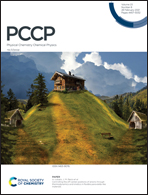Anion–anion and anion–neutral triel bonds†
Abstract
The ability of a TrCl4− anion (Tr = Al, Ga, In, Tl) to engage in a triel bond with both a neutral NH3 and CN− anion is assessed by ab initio quantum calculations in both the gas phase and in aqueous medium. Despite the absence of a positive σ or π-hole on the Lewis acid, strong triel bonds can be formed with either base. The complexation involves an internal restructuring of the tetrahedral TrCl4− monomer into a trigonal bipyramid shape, where the base can occupy either an axial or equatorial position. Although this rearrangement requires a substantial investment of energy, it aids the complexation by imparting a much more positive MEP to the site that is to be occupied by the base. Complexation with the neutral base is exothermic in the gas phase and even more so in water where interaction energies can exceed 30 kcal mol−1. Despite the long-range coulombic repulsion between any pair of anions, CN− can also engage in a strong triel bond with TrCl4−. In the gas phase, complexation is endothermic, but dissociation of the metastable dimer is obstructed by an energy barrier. The situation is entirely different in solution, with large negative interaction energies of as much as −50 kcal mol−1. The complexation remains an exothermic process even after the large monomer deformation energy is factored in.



 Please wait while we load your content...
Please wait while we load your content...